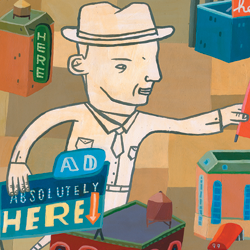|
REGISTRATION REQUIRED
exhibiting 101
 Post-Show Paperwork
Ensure that your outbound freight arrives at its next destination on time – and without any last-minute snafus – by heeding these tips and reminders about end-of-show forms and paperwork. By Betsy Earle
As someone who has been the sole person supervising the teardown and packing of a client's exhibit property on more than one occasion, I totally understand how tired exhibitors are at the end of a show – and how badly you want to put your feet up or treat yourself and your team to a celebratory dinner for a job well done. But the truth is that the job isn't done until all of your freight is properly packed and on its way to its next destination. A lot of details need to be addressed before that can happen, and as is often the case in the world of trade show exhibiting, that means reviewing and/or completing multiple forms and documents.
It's easy to overlook or rush through end-of-show paperwork when you're busy with teardown and looking ahead to your next exhibiting endeavor. At one trade show in particular, I needed to ship various parts of one exhibit to 11 different destinations. Without proper planning, keeping my team and the maze of outbound boxes and pallets organized would have been like trying to get ducks to walk in a straight line. Thankfully, we had all our paperwork in order long before the dismantle crew set one foot in the booth. So to help you close your next show just as smoothly, here is a primer on the documents you'll need to familiarize yourself with and my tips to ensure your freight gets to where it needs to be on time and on budget. Outbound Schedules The outbound schedule, i.e., the document outlining when your empty crates will be brought to your exhibit for dismantle and when your carrier should arrive at the marshaling yard, is determined by a number of factors, such as what exhibit hall your booth is in, your location within that hall, priority points, and show management's contractual arrangement with the venue. Typically found in the shipping or "Quick Facts" section of the show kit, the outbound schedule should be reviewed and shared with your carrier as early as possible. ➤ Note what time your carrier must arrive at the marshaling yard, which is often well before your teardown needs to be completed. For example, you may have until noon after the show closes to make sure your freight is ready for pickup, but show management could require that all carriers check in and receive their loading-dock assignments by no later than 9 a.m. ➤ Rather than firing off a quick email to my carrier letting it know when the driver should be on site, I prefer to send a PDF of the entire outbound schedule. This negates the risk of any typos and gives my carrier the full picture of the move-out process. ➤ Keep in mind that some carriers will slap you with a wait-time fee if the driver arrives at the designated time and your freight isn't ready to hit the road. If the outbound schedule gives you a longer pickup window, e.g., the option for your carrier to arrive the morning after the show closes versus later that same evening, I recommend giving yourself as much time as possible to prepare your shipment. ➤ Reps from the general service contractor (GSC) or show management may leave a notice in your booth toward the end of the show that lists changes to the original outbound schedule, such as when your empty crates are expected to return to your booth or a truncated time frame for tearing down your exhibit. Pay close attention to the details in this document to make sure your dismantle team and carrier have an accurate, up-to-date picture of the teardown and outbound-shipping process. Shipping Manifests These documents, which may be prepared by an exhibit house or a member of your internal team, list the components coming to the show, the quantity of each item, and the crate or pallet in which they are packed. Depending on the nature of your exhibit, in-booth activities, and shipping requirements, it may be helpful to prepare a separate manifest for your outbound freight. ➤ It's not uncommon for an exhibitor to need to send freight from one exhibit to multiple destinations, e.g., one pallet of equipment to another show, two boxes of giveaways to the corporate office, and a crate of graphics to a storage facility. In cases like this, adequate pre-show planning is essential. Before I even arrive on site, I like to create either a spreadsheet or a picture-heavy PDF document that identifies the components going to each destination. For example, if I have a lot of graphics that need to be sent directly from the show floor to another venue, I typically print a PDF with one page for each graphic needed for the next show. This PDF effectively serves as a manifest and gets packed right inside of the crate with the selected graphics. ➤ Outbound manifests are also useful for updating your exhibit inventory. For instance, I have one client that uses a lot of toothpicks and appetizer napkins during a show. In the outbound manifest, then, I will note that there are three boxes of toothpicks in the shipment, down from the original 12. I also like to email my outbound manifests to my clients to give them a heads up on their current level of exhibiting supplies. ➤ Whether you create new manifests for your outgoing freight or reuse your inbound documents, I recommend affixing these forms to the inside of your departing shipments so that whoever opens the package next knows what's been put where. Outbound Shipping Labels Outbound labels should be clearly placed on all pieces of freight at the close of the show. Some GSCs give exhibitors the option of ordering their shipping labels online through the show-services portal. The GSC then handles the printing process and includes the labels with your Material Handling Agreement (MHA). Other GSCs provide a kiosk near the exhibitor service desk where you can print your labels yourself. Personally, I prefer to print my own labels prior to the show because I like to make them oversized and incorporate large type sizes and bright colors that stand out. GSC-provided labels tend to be small and use tiny fonts, and in my experience, anything that helps distinguish your freight will only improve its chances of getting to where it needs to be. ➤ I recommend affixing permanent transparent-plastic sleeves (aka job pockets) to the outside of your crates that can accommodate larger, self-printed shipping labels to help you avoid needing to remove the sticky residue from old adhesive labels. ➤ Always double check that any old shipping labels have been removed from your pallets, crates, and boxes to circumvent your shipment ending up in material-handling purgatory. ➤ Placing your shipping labels on more than one side of your freight will ensure that essential information is visible regardless of how the shipment is palletized and/or loaded.
Don't make the common rookie mistake of leaving a signed Material Handling Agreement in your soon-to-be-empty booth space.
Material Handling AgreementsThe MHA is the document that gives the GSC permission to move your freight from the booth space to the loading dock and release it to either your designated carrier or the show's preferred carrier. This important document must be turned in to the exhibitor services desk at the close of the show after your freight is packed. (If you're sending freight to multiple locations, you must complete an MHA for each individual destination.) You will then receive a signed copy from the GSC confirming its receipt. ➤ Do not make the rookie mistake of leaving a signed MHA in your soon-to-be-empty booth space. Keep this copy with you, or take a page from my playbook and email a photo of it to your colleagues should a complication arise when you're unavailable. ➤ Check and double check that the number of pieces in your shipment match the number listed on the MHA. If you have pieces on the show floor that have not been accounted for, the GSC will not release those packages to the shipping company. ➤ Be sure your dismantle team and carrier are on the same page regarding company names, as discrepancies could result in the GSC not releasing your freight. I had this occur when my teardown crew put my company's name on the MHA, but the carrier's paperwork listed only our client's name. Thankfully, a colleague was on site and able to sort out the situation; otherwise, the carrier would have left the venue with an empty trailer. Bills of Lading A lot of "permission" is needed to pass exhibit properties between parties at the end of a show. As the exhibitor, you need to grant permission to the GSC to release your exhibit property to your carrier via the MHA. Additionally, the carrier needs permission to take this freight, which creates the need for another document called the Bill of Lading (BOL). Many people confuse BOLs and MHAs, including the reps at the exhibitor services desk. Essentially, the MHA is an agreement between an exhibitor and the GSC, while the BOL is an agreement between the GSC and the carrier. Exhibitors do not need to complete a BOL – your carrier will provide one when it drops off and picks up your freight – but there are still I's to be dotted and T's to be crossed. ➤ As with an MHA, it is essential that the company name on the BOL match the name on the shipping labels.➤ To avoid confusion and last-minute snafus on the loading dock, ask your carrier to be specific when defining the pieces in your shipment. For example, if you have a machine that's pad wrapped and needs special care, communicate that to your carrier. And when indicating the number of pallets with stretch wrap, include the color of the wrapping. Closing a show is a duty that unfortunately needs to be done when most of us are not exactly firing on all cylinders. But the more planning you do in advance, the quicker you will get to your next show – or to bed. E  Betsy Earle, CTSM
Betsy Earle, CTSMmanaging director and founder of Event Driven Solutions LLC. Earle obtained her MBA at the University of Miami and earned her Diamond-level CTSM designation in 2018. Exhibiting101@exhibitormagazine.com
|
|
|
||||||||||||||||||||||||||||
|
|
||||||||||||||||||||||||||||
|
TOPICS Measurement & Budgeting Planning & Execution Marketing & Promotion Events & Venues Personal & Career Exhibits & Experiences International Exhibiting Resources for Rookies Research & Resources |
MAGAZINE Subscribe Today! Renew Subscription Update Address Digital Downloads Newsletters Advertise |
FIND IT Exhibit Producers Products & Services All Companies Get Listed |
EXHIBITORLIVE Sessions Exhibit Hall Exhibit at the Show Registration |
ETRAK Sessions Certification F.A.Q. Registration |
EDUCATION WEEK Overview Sessions Hotel Registration |
CERTIFICATION The Program Steps to Certification Faculty and Staff Enroll in CTSM Submit Quiz Answers My CTSM |
AWARDS Exhibit Design Awards Portable/Modular Awards Corporate Event Awards Centers of Excellence |
NEWS Associations/Press Awards Company News International New Products People Shows & Events Venues & Destinations EXHIBITOR News |
||||||||||||||||||||
|
||||||||||||||||||||||||||||






